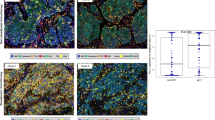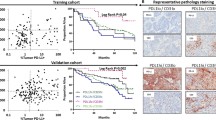Abstract
Objectives
To date, there are no data on the noninvasive surrogate of intratumoural immune status that could be prognostic of survival outcomes in non-small cell lung cancer (NSCLC). We aimed to develop and validate the immune ecosystem diversity index (iEDI), an imaging biomarker, to indicate the intratumoural immune status in NSCLC. We further investigated the clinical relevance of the biomarker for survival prediction.
Methods
In this retrospective study, two independent NSCLC cohorts (Resec1, n = 149; Resec2, n = 97) were included to develop and validate the iEDI to classify the intratumoural immune status. Paraffin-embedded resected specimens in Resec1 and Resec2 were stained by immunohistochemistry, and the density percentiles of CD3+, CD4+, and CD8+ T cells to all cells were quantified to estimate intratumoural immune status. Then, EDI features were extracted using preoperative computed tomography to develop an imaging biomarker, called iEDI, to determine the immune status. The prognostic value of iEDI was investigated on NSCLC patients receiving surgical resection (Resec1; Resec2; internal cohort Resec3, n = 419; external cohort Resec4, n = 96; and TCIA cohort Resec5, n = 55).
Results
iEDI successfully classified immune status in Resec1 (AUC 0.771, 95% confidence interval [CI] 0.759–0.783; and 0.770 through internal validation) and Resec2 (0.669, 0.647–0.691). Patients with higher iEDI-score had longer overall survival (OS) in Resec3 (unadjusted hazard ratio 0.335, 95%CI 0.206–0.546, p < 0.001), Resec4 (0.199, 0.040–1.000, p < 0.001), and TCIA (0.303, 0.098–0.944, p = 0.001).
Conclusions
iEDI is a non-invasive surrogate of intratumoural immune status and prognostic of OS for NSCLC patients receiving surgical resection.
Key Points
• Decoding tumour immune microenvironment enables advanced biomarkers identification.
• Immune ecosystem diversity index characterises intratumoural immune status noninvasively.
• Immune ecosystem diversity index is prognostic for NSCLC patients.




Similar content being viewed by others
Abbreviations
- AJCC:
-
American Joint Committee Cancer
- AUC:
-
Area under the ROC curve
- CI:
-
Confidence interval
- iAUC:
-
Integrated area under the ROC curve
- iBS:
-
Integrated Brier score
- iEDI:
-
Immune ecosystem diversity index
- LASSO:
-
The least absolute shrinkage and selection operator
- NCCN:
-
National Comprehensive Cancer Network
- NNE:
-
Nearest Neighbor Estimation
- NSCLC:
-
Non-small cell lung cancer
- OS:
-
Overall survival
- ROC:
-
Receiver operating characteristic
- TIME:
-
Tumour immune microenvironment
- TNM:
-
Tumour-node-metastasis
References
Siegel RL, Miller KD, Jemal A (2018) Cancer statistics. CA Cancer J Clin 68(1):7–30
Edge S, Byrd D, Compton C, Fritz A, Greene F, Trotti A (2010) AJCC cancer staging manual, 7th edn. Springer, Berlin Heidelberg New York
Donnem T, Hald SM, Paulsen EE et al (2015) Stromal CD8+ T-cell density-a promising supplement to TNM staging in non-small cell lung cancer. Clin Cancer Res 21(11):2635–2643
Donnem T, Kilvaer TK, Andersen S et al (2016) Strategies for clinical implementation of TNM-Immunoscore in resected nonsmall-cell lung cancer. Ann Oncol 27(2):225–232
Junttila MR, de Sauvage FJ (2013) Influence of tumour micro-environment heterogeneity on therapeutic response. Nature 501(7467):346–354
Natrajan R, Sailem H, Mardakheh FK et al (2016) Microenvironmental heterogeneity parallels breast cancer progression: a histology-genomic integration analysis. PLoS Med 13(2):e1001961
Binnewies M, Roberts EW, Kersten K et al (2018) Understanding the tumour immune microenvironment (TIME) for effective therapy. Nat Med 24(5):541–350
Fridman WH, Pages F, Sautes-Fridman C, Galon J (2012) The immune contexture in human tumours: impact on clinical outcome. Nat Rev Cance 12(4):298–306
Bremnes RM, Busund LT, Kilvaer TL et al (2016) The role of tumour-infiltrating lymphocytes in development, progression, and prognosis of non-small cell lung cancer. J Thorac Oncol 11(6):789–800
Galon J, Mlecnik B, Bindea G et al (2014) Towards the introduction of the 'Immunoscore' in the classification of malignant tumours. J Pathol 232(2):199–209
Sun R, Limkin EJ, Vakalopoulou M et al (2018) A radiomics approach to assess tumour-infiltrating CD8 cells and response to anti-PD-1 or anti-PD-L1 immunotherapy: an imaging biomarker, retrospective multicohort study. Lancet Oncol 19(9):1180–1191
Rizvi NA, Hellmann MD, Snyder A et al (2015) Cancer immunology. Mutational landscape determines sensitivity to PD-1 blockade in non-small cell lung cancer. Science 348(6230):124–128
Tumeh PC, Harview CL, Yearley JH et al (2014) PD-1 blockade induces responses by inhibiting adaptive immune resistance. Nature 515(7528):568–571
Herbst RS, Soria JC, Kowanetz M et al (2014) Predictive correlates of response to the anti-PD-L1 antibody MPDL3280A in cancer patients. Nature 515(7528):563–567
Li B, Cui Y, Diehn M, Li R (2017) Development and validation of an individualized immune prognostic signature in early-stage nonsquamous non-small cell lung cancer. JAMA Oncol 3(11):1529–1537
Steele KE, Tan TH, Korn R et al (2018) Measuring multiple parameters of CD8+ tumour-infiltrating lymphocytes in human cancers by image analysis. J Immunother Cancer 6(1):20
Yan X, Jiao SC, Zhang GQ, Guan Y, Wang JL (2017) Tumor-associated immune factors are associated with recurrence and metastasis in non-small cell lung cancer. Cancer Gene Ther 24(2):57–63
Domagala-Kulawik J, Raniszewska A (2017) How to evaluate the immune status of lung cancer patients before immunotherapy. Breathe 13(4):291–296
Grossmann P, Stringfield O, El-Hachem N et al (2017) Defining the biological basis of radiomic phenotypes in lung cancer. Elife 6:e23421
Aerts HJ, Velazquez ER, Leijenaar RT et al (2014) Decoding tumour phenotype by noninvasive imaging using a quantitative radiomics approach. Nat Commun 5:4006
National Comprehensive Cancer Network (NCCN) (2014) NCCN clinical practice guidelines in oncology: non-small cell lung cancer, V4. 2014. http://www.nccn.org/professionals/physician_gls/pdf/nscl.pdf. Accessed August 15, 2014.
Heagerty PJ, Lumley T, Pepe MS (2000) Time-dependent ROC curves for censored survival data and a diagnostic marker. Biometrics 56(2):337–344
Fraley C, Raftery AE (2002) Model-based clustering, discriminant analysis, and density estimation. Journal of the American Statistical Association 97(458):611–631
El Naqa I, Ten Haken RK (2018) Can radiomics personalise immunotherapy? Lancet Oncol 19(9):1138–1139
Maley CC, Koelble K, Natrajan R, Aktipis A, Yuan Y (2015) An ecological measure of immune-cancer colocalization as a prognostic factor for breast cancer. Breast Cancer Res 17(1):131
Maley CC, Aktipis A, Graham TA et al (2017) Classifying the evolutionary and ecological features of neoplasms. Nat Rev Cancer 17(10):605–619
Pienta KJ, McGregor N, Axelrod R, Axelrod DE (2008) Ecological therapy for cancer: defining tumours using an ecosystem paradigm suggests new opportunities for novel cancer treatments. Transl Oncol 1(4):158–164
Merlo LM, Pepper JW, Reid BJ, Maley CC (2016) Cancer as an evolutionary and ecological process. Nat Rev Cancer 6(12):924–935
Zwanenburg A, Vallières M, Abdalah MA et al (2020) The image biomarker standardization initiative: standardized quantitative radiomics for high-throughput image-based phenotyping. Radiology 295(2):328–338
Tang C, Hobbs B, Amer A et al (2018) Development of an immune-pathology informed radiomics model for non-small cell lung cancer. Sci Rep 8(1):1922
Aerts HJ (2016) The Potential of Radiomic-Based Phenotyping in Precision Medicine: a Review. JAMA Oncol 2(12):1636–1642
Jiang Y, Wang H, Wu J et al (2020) Noninvasive imaging evaluation of tumour immune microenvironment to predict outcomes in gastric cancer. Ann Oncol 31(6):760–768
Rakaee M, Kilvaer TK, Dalen SM et al (2018) Evaluation of tumor-infiltrating lymphocytes using routine H&E slides predicts patient survival in resected non-small cell lung cancer. Hum Pathol 79:188–198
Ogino S, Giannakis M (2018) Immunoscore for (colorectal) cancer precision medicine. Lancet 391(10135):2084–2086
Salgado R, Denkert C, Demaria S et al (2015) The evaluation of tumor-infiltrating lymphocytes (TILs) in breast cancer: recommendations by an International TILs Working Group 2014. Ann Oncol 26(2):259–271
Ferris RL, Galon J (2016) Additional support for the introduction of immune cell quantification in colorectal cancer classification. J Natl Cancer Inst 108(8):djw033.
Ascierto PA, Capone M, Urba WJ et al (2013) The additional facet of immunoscore: immunoprofiling as a possible predictive tool for cancer treatment. J Transl Med 11:54
Acknowledgements
We thank The Cancer Imaging Archive.
Funding
This study was supported by the National Key Research and Development Program of China (grant number 2021YFF1201003), the Key R&D Program of Guangdong Province of China (grant number 2021B0101420006), the National Science Fund for Distinguished Young Scholars (grant number 81925023), and the National Natural Scientific Foundation of China (grant number 81771912, 81901910, 82071892, and 82001986), the High-level Hospital Construction Project (DFJHBF202105). The funding sources had no involvement in study design, in the collection, analysis, and interpretation of data, in the writing of the report, and in the decision to submit the article for publication.
Author information
Authors and Affiliations
Corresponding authors
Ethics declarations
Guarantor
The scientific guarantor of this publication is Zaiyi Liu.
Conflict of interest
The authors of this manuscript declare no relationships with any companies, whose products or services may be related to the subject matter of the article.
Statistics and biometry
One of the authors has significant statistical expertise.
Informed consent
Written informed consent was waived by the Institutional Review Board.
Ethical approval
Institutional Review Board approval was obtained.
Methodology
• retrospective
• prognostic study
• multicentre study
Additional information
Publisher’s note
Springer Nature remains neutral with regard to jurisdictional claims in published maps and institutional affiliations.
Supplementary information
ESM 1
(DOCX 1648 kb)
Rights and permissions
About this article
Cite this article
He, L., Li, ZH., Yan, LX. et al. Development and validation of a computed tomography–based immune ecosystem diversity index as an imaging biomarker in non-small cell lung cancer. Eur Radiol 32, 8726–8736 (2022). https://doi.org/10.1007/s00330-022-08873-6
Received:
Revised:
Accepted:
Published:
Issue Date:
DOI: https://doi.org/10.1007/s00330-022-08873-6




